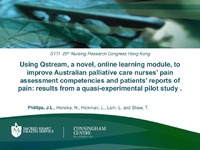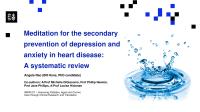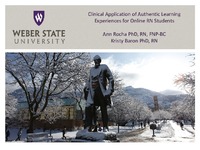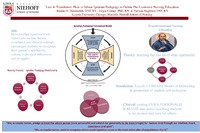| dc.contributor.author | Phillips, Jane L. | en |
| dc.contributor.author | Heneka, Nicole | en |
| dc.contributor.author | Shaw, Tim | en |
| dc.contributor.author | Hickman, Louise D. | en |
| dc.contributor.author | Lam, Lawrence T. | en |
| dc.date.accessioned | 2014-11-17T13:51:53Z | |
| dc.date.available | 2014-11-17T13:51:53Z | |
| dc.date.issued | 2014-11-17 | |
| dc.identifier.uri | http://hdl.handle.net/10755/335413 | |
| dc.description | <p>International Nursing Research Congress, 2014 Theme: Engaging Colleagues: Improving Global Health Outcomes. Held at the Hong Kong Convention and Exhibition Centre, Wanchai, Hong Kong</p>
<p>This project was funded by the Curran Foundation and The St Vincent's Clinic Multi-disciplinary Research grants, Sydney Australia.</p> | en |
| dc.description.abstract | <p>Session presented on Monday, July 28, 2014:</p>
<p>Purpose: Pain is a complex multidimensional phenomenon moderated by consumer, provider and health system factors. Even within specialist cancer and palliative care settings where pain is almost always universally experienced by patients, there is often poor compliance with routine pain screening and assessment practices, with patient reported pain intensity ratings frequently not documented. 1 2 Effective pain management in these specialist care settings cuts across professional boundaries, with failure to screen and assess contributing to the burden of unrelieved pain. Translating evidence into practice and changing behaviour in dynamic clinical environments is challenging, and requires a systematic and critical analysis of priorities and presumed causes. A range of predisposing, enabling and reinforcing factors are known to shape clinicians pain assessment practices, including: their assessment knowledge, skills and practices (competencies)3; understanding of suitable assessment tools; commitment and capacity to integrate pain assessment findings into clinical decision making 4; communication skills; and capacity to address their patients' care needs within the context of multi-professional practice. 5 While numerous education interventions have been developed to address these gaps in the cancer or specialist palliative care settings 6, few have targeted pain assessment as a distinct and separate learning component, with most embedding assessment into the overall pain management intervention. 1 Implementing an intervention that increases nurses' pain assessment capabilities is required to improve patient reported pain outcomes. Qstream is an on-line learning platform, that takes advantage of the psychological finding that education encounters which are 'spaced' and 'repeated over time' result in more efficient learning and improved retention compared to a bolus distribution learning format. 7 The Qstream learning platform delivers clinical content questions to participants via regular email. In over 12 randomised controlled trials, Qstream has been demonstrated to: increase health professionals' clinical knowledge and competencies; promote active learning and retention in specialist areas; impact on clinical practice; and change clinicians' behaviour. 8-10 The primary aim of this study was to test the impact of a Qstream pain assessment learning module on specialist palliative care nurses' pain assessment competencies, and to determine if this education impacted positively on palliative care patients' reported pain ratings.</p>
<p><strong>Methods:</strong> This quasi-experimental (pre-post-test) pilot continuing professional development intervention study was conducted at two Australian specialist palliative care services in 2012. All of the 103 registered and enrolled nurses (nurses) employed for more than 16 hours per week at these services were invited to participate. The continuing professional development intervention consisted of 11 case based pain assessment scenarios developed by a multidisciplinary expert panel delivered to participants via Qstream over 28 days. The 'Self-Perceived Pain Assessment Competencies' (Self-PAC) survey and chart audit data (n=60), including patient reported pain intensity ratings, were collected pre (Time 1) and post intervention (Time 2) and analysed using inferential statistics to determine key outcomes. The Self-PAC-Survey has three distinct sub-scales, with Cronbach alpha reporting acceptable internal consistency reliability: seven item pain assessment knowledge (0.944); three item pain assessment tool knowledge (0.846); and seven item pain assessment confidence (0.919) scales. Independent sample t-test were used to compare the 'responders' (participants who completed the Time 1 and Time 2 survey's and the intervention) and 'non-responders' (participants who only completed the Time 1 survey). A paired sample t-test was used to determine if there was a difference between nurses' pain assessment: knowledge, tool awareness and confidence scores at Time 1 and Time 2. The difference in number of documented pain ratings in the medical records by Qstream participants between Time 1 and Time 2 was calculated and the association between Qstream participation and assessments at the two time points was examined using Pearson chi-square test.'Differences in patient reported pain rating between admission and audit date were examined using paired t-test. A significance level of 5% was used for all hypothesis testing.</p>
<p><strong>Results: </strong>The results reported conform to the STROBE Guidelines. Thirty Four nurses out of the 74 who enrolled in the study completed the intervention and the Time 1 and Time 2 surveys. Participants felt more confident documenting their pain assessment findings following the learning module (mean 7.52 to 8.17) with participants also more confident undertaking a comprehensive pain assessment at the end of the program compared to baseline (mean 7.27 vs. 8.24). Participants were more likely to document pain intensity scores in patient's medical records than non-participants (95% C.I.=7.3% - 22.7% , p=0.021). Qstream participants increased their knowledge of comprehensive pain assessment elements, assessment tools and confidence to undertake a pain assessment (p<0.001). There was also a significant reduction in the mean patient reported pain ratings between the admission and audit date at post-test (mean=2.4) compared to pre-test (mean=3.9) (t=1.51,df= 82, p<.0010).11).</p>
<p><strong>Conclusion:</strong> This pilot confirms the Qstream delivery method as an online learning format with the capacity to improve specialist palliative care nurses' pain assessment practices and reduce patient rated pain intensity scores. Given the central role nurses play in pain assessment processes this is an important result. Especially as determining the best way of managing the patients' pain is dependent upon systematic and robust assessment, identification of the underlying pain mechanism, and integration of appropriate multi-modal approaches tailored to address each patient's pain requirements. An adequately powered larger pragmatic trial with a larger sample is required to confirm these results. There is potential for Qstream to be integrated into larger multi-faceted translational research interventions targeting nurses' knowledge, attitudes and practices.</p> | en |
| dc.description.sponsorship | Curran Foundation | en |
| dc.description.sponsorship | Saint Vincent's Clinic | en |
| dc.format | Text-based Document | en |
| dc.language.iso | en | en |
| dc.subject | Translational Research | en |
| dc.subject | On-line Learning | en |
| dc.subject | Pain Assessment | en |
| dc.title | Using an online learning module to improve Australian palliative care nurses' pain assessment competencies and patients' reports of pain | en |
| dc.type | Presentation | en |
| dc.rights.holder | <p>
All rights reserved by the author(s) and/or publisher(s) listed in this item record unless relinquished in whole or part by a rights notation or a Creative Commons License present in this item record.
</p><p>
All permission requests should be directed accordingly and not to the Sigma Repository.
</p><p>
All submitting authors or publishers have affirmed that when using material in their work where they do not own copyright, they have obtained permission of the copyright holder prior to submission and the rights holder has been acknowledged as necessary.
</p> | en |
| dc.description.note | <p>Items submitted to a conference/event were evaluated/peer-reviewed at the time of abstract submission to the event. No other peer-review was provided prior to submission to the Henderson Repository.</p> | |
| dc.type.category | Full-text | en |
| dc.evidence.level | N/A | en |
| dc.research.approach | N/A | en |
| dc.contributor.department | Non-member | en |
| dc.author.details | Jane L. Phillips, RN, BS, PhD; Nicole Heneka, MHumNut; Tim Shaw, BSc (H1), PhD; Louise D. Hickman, BN, RN, MPH, PhD; Lawrence T. Lam, PhD, MPubH, MAppPsy, BSc (Hons) | en |
| dc.conference.name | 25th International Nursing Research Congress | en |
| dc.conference.host | Sigma Theta Tau International | en |
| dc.conference.location | Hong Kong | en |
| dc.date.conferenceyear | 2014 | |
| dc.description.reviewtype | Abstract Review Only: Reviewed by Event Host | en |
| dc.description.acquisition | Proxy-submission | en |





